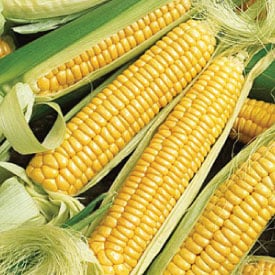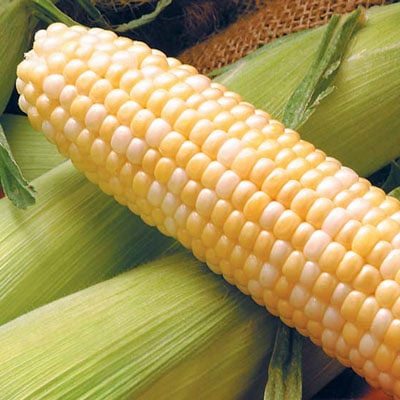
Learning Download: How to Grow Corn
From Seed to Harvest: A beginner’s guide to growing corn.
Indiana is home to many acres of massive corn fields, but corn can be grown in a home garden, too. Sweet corn is a popular summer vegetable to grow in the home garden. Many cornfields consist of fields corn, which is starchier but sweet corn, like its name, has a sweeter taste and the kernels are softer.
Different types of sweet corn should not be planted together. Corn comes in many different varieties but if planted near each other, the types can cross and create a starchier corn.
Corn is grown for its cob, to make popcorn or for ornamental decoration. It can be made in a variety of different ways, such as grilling, boiling or steaming.
Different types of sweet corn:
Sweet corn comes in three different types – normal sugar-enhanced and super sweet. The different types include different levels of sucralose, which changes the flavor of the corn. Normal sweet corn’s sugars turn to starch quicker after harvest, but sugar-enhanced and super sweet corn stays sweeter longer. Sugar-enhanced sweet corn is more tender than the others, and super sweet corn needs warmer, moister soil to germinate compared to the other types of corn. Sweet corn can be yellow, white or multicolored like some heirloom varieties.
Some varieties include: the Silver Queen, this variety is known to be so tender and sweet, it can often be eaten raw. Golden Bantam, a variety that has a fast maturing time with a sweet taste. Although often known for its yellow or white kernels, sweet corn can come in heirloom varieties and grow in other colors, like red.
Sugar values of corn:
Sweet corn has a lower starch content and higher sugar content and is composed of up to 18 percent sugar, most of which is sucralose. Foods with high sugar can be ranked high on the glycemic index, which can then lead to increased blood sugar and unhealthy side effects. Despite its sweetness, sweet corn doesn’t rank high on the glycemic index, making it a healthier option for those with a sweet tooth.
To plant:
It is not recommended to start corn seeds indoors. Corn should be first planted outside in the garden two weeks after the last spring frost. Sweet corn is a warm-weather plant, and the soil must be warmer than at least 55 degrees Fahrenheit upon planting. If planting super sweet corn, wait for the soil to warm up to at least 65 degrees Fahrenheit. Since sweet corn has a long growing season, the best way to plant sweet corn is to plant an early variety and then plant again further into the season. For colder areas, warm the soil by placing black plastic across the area planned for the sweet corn and plant the seeds through holes in the plastic. Corn is best grown not in rows but in square plots, as it is pollinated by wind.
Planting dates for sweet corn:
- Zone 2: June 15
- Zone 3: May 31
- Zone 4: May 15
- Zone 5 : May 1
- Zone 6: April 15
- Zone 7: April 1
- Zone 8: March 15
- Zone 9: March 1
To learn more about USDA hardiness Growing Zones, click here.
Plant seeds 1 inch deep and 4 inches apart in rows set 3 feet apart. Water the corn seeds well as soon as you plant them.
To grow:
Once plants reach 4 inches tall, you may thin them to grow 8 to 12 inches apart. Corn must be well-watered due to their shallow roots. Corn requires 5 gallons of watering per square foot of crop. Also, weed carefully to not damage the roots. Water retention may be done by mulching the corn plants. Corn requires well-drained soil with a pH of 6.0 to 6.8.
To harvest:
Corn is ready to harvest when its tassels are brown and the cobs swell, which is approximately 20 days after the silks appear. To harvest, pull the cob down and twist it off the stalk.
What corn crave:
Fertilization can be done at the time of plating, as corn is meant to grow quickly, and it is a hungry plant. Fertilize the corn every 30 days. Once the fertilizer has been released, water well. Corn doesn’t prefer a certain kind of fertilizer, so fertilizer by following the fertilizer brand’s instructions.
Where to buy corn seeds:
You can find many different varieties of corn seeds, including sweet corn, white corn and more at Urban Farmer.
Learning Download: Common pests and diseases: Corn
Common pests and diseases: Corn
When growing vegetables, it is always exciting to care for the plant throughout its growing phase and then harvest it for delicious recipes later on, but one thing to watch out for is pests and diseases. Different plants are susceptible to different types of pests and diseases, and it is important to make yourself aware so you can keep a watchful eye and also take any preventative methods to keep your plants safe throughout their lifespan.
Corn can fall victim to several different pests and diseases.
Pests:
There are several pest which affect corn, such as corn earworm, European corn borer, corn sap beetles, corn root aphids, wireworms, seed corn maggots and raccoons.
Corn earworms also are known as the tomato fruitworm or cotton bollworm. It is a caterpillar that can reach up to 2 inches long, and it can be green or purple-brown in color. These worms prevent pollination, and the larvae of the worms feed on the silks and kernels. To prevent these worms, squirt mineral oil into each ear of corn after the silks have begun to dry, and you can also spray the silk and the entire plant with Bt. Cut off the tip of the corn’s ear or any affected kernels if there is earworm damage, but you can eat the rest of the ear.
The European corn borer is a 1-inch long caterpillar that’s brown with rows of brown spots. Larvae will bore into the stalks and ears. Signs of corn borer damage include bent stalks and broken tassels. Treat ears and leaves with Bt as soon as the silks partially emerge to prevent this from happening and spray with a pesticide every five days if you spot borer activity.
Corn sap beetles are black beetles that create larvae similar to maggots, which eat the kernels of roasting corn. Plant resistant varieties and be sure to clean up all the crop residue to prevent this from happening.

Corn root aphids are light green bugs that feed on the corn’s roots and this makes the plant become stunted and yellowed. Sprinkle wood ash over the plants and soil to keep these bugs away.
Seed corn maggots bore into the corn’s sprouting seeds and keep them from growing further. Seeds are more susceptible if planted in cool, wet soil early in the season.
Raccoons target ripening sweet corn, so to keep them out of the garden, add a 3-foot chicken wire fence topped with electrical wire or play a portable radio in the cornfield all night.
Diseases:
Corn plants can fall victim to diseases such as Stewart’s bacterial wilt and corn smut.
Stewart’s bacterial wilt can effect sweet corn at any stage of its growth, but it is the most harmful to young plants. It can cause dwarfing and wilting. Leaves will have wavy edges and develop yellow-brown streaks. To prevent this, clean all your crop residue, utilize crop rotation and control corn flea beetles.
Corn smut is caused by a soil fungus, but if it affects your plants, they are still edible. Grayish white galls will appear on the ear or tassel as they ripen, they become black and burst open, which spreads the smut. This fungus does best in hot and dry weather and will usually target weak plants first. Rotate crops and pick the galls off if you notice them and then burn them before they blacken.

